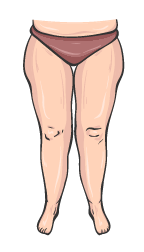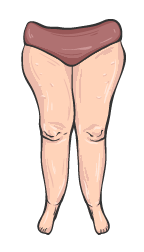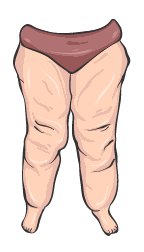Stages of Lipedema

This image was made by and is copyrighted by Pain & Swelling Solutions.
The Stages of Lipedema Explained
Early tell-tale signs of Lipedema are the development of a cuff around the ankle where the fat distribution stops (the foot is usually normal size), extreme sensitivity, pain, swelling, and easy bruising.
In later stages of Lipedema, the leg typically develops a column-like shape and the skin begins to pucker.
As the disease progresses, the skin begins to develop hanging folds, and in the final stages the fat distribution can become severe enough to greatly impede mobility.
In the final stages, the fat and fascia can impede the flow of lymph by constricting the lymphatic vessels. When this happens, a secondary condition known as Lymphedema develops. When a person has both Lipedema and Lymphedema, the condition is then called Lipo-Lymphedema.

Stage 1 Lipedema
Stage 1 of Lipedema looks mostly like normal legs.
They may appear to be a bit puffy and have a distinctive marshmallow-like feeling when touched.
Stage 1 “Lippy Legs” (as they are referred to by women with the condition) may appear to have swelling – as if someone has been standing all day long.
In all of the stages of Lipedema, this is the one that is most often overlooked by physicians. Women are usually told to reduce salt and lose weight.
Since it doesn’t look like a disease, it isn’t treated as such. Women in this stage of Lipedema typically feel that something is not normal but have a hard time convincing others that it is true.

Stage 2 Lipedema
Stage 2 “Lippy Legs” also have the marshmallow-like feel to them, but they take on a few new characteristics.
- Indentations in the skin – this is caused by fascial knots forming around swollen fat cells and pulling together causing a puckering.
- Definitive cuffs at the ankle that are an area of demarcation where the lipedema cells start and stop. The feet are not affected in lipedema.
- Shelf-like shapes appear where the thighs meet the knees.
Numbers 2 & 3 are evident, but not readily apparent in Stage 1.

Stage 3 Lipedema
In Stage 3, Lipedema goes from looking like someone who has “big legs” to a more disfiguring appearance. The following changes are apparent in Stage 3:
- Significant fat deposition throughout the legs, often forming a “sweat pant” column on the lower legs.
- Fat begins to form folds and hang over the hips, knees, and ankles.
- The tissue of the legs becomes fibrous and harder feeling to the touch.

Stage 4 Lipedema
Stage 4 becomes severely compromising to health. In addition to the mobility challenges that the large deposits of fat cause, other systems of the body become affected.
When legs reach Stage 4, the lymphatic system is compromised which causes a perpetual backup of fluid. Over time this develops into Lymphedema. The condition is then often referred to as “Lipo-Lymphedema.”
Symptoms in Stage 4 include weeping of fluid from the legs, extreme swelling, and the development of abnormal growths.

